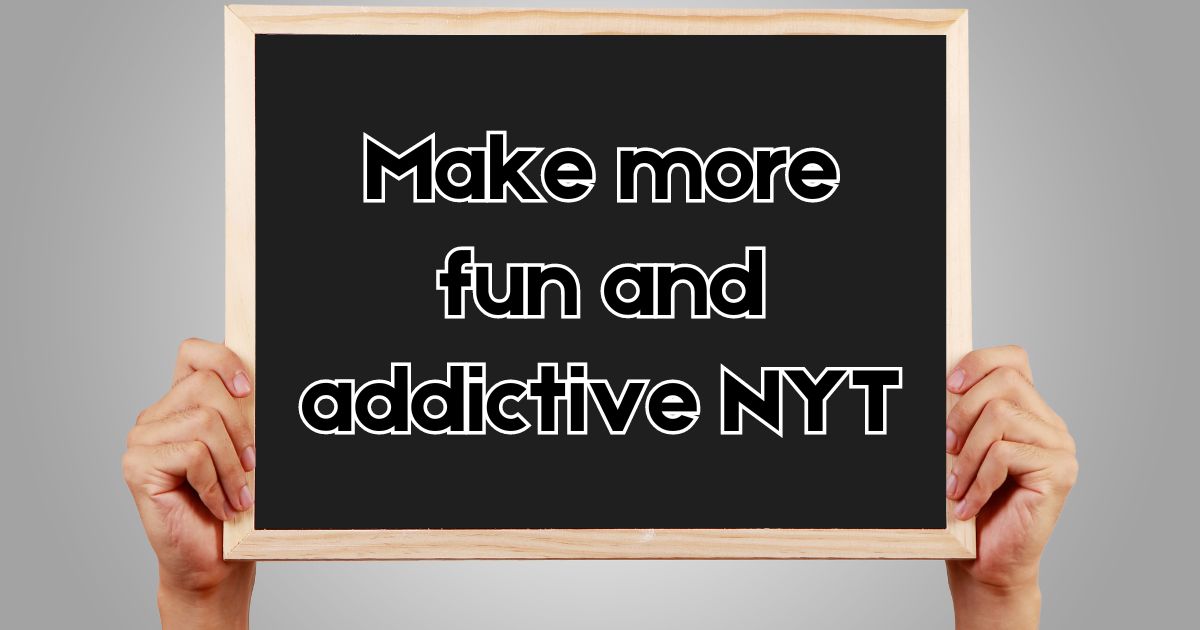The New York Times (NYT) is not only a leading source of news and information but also a platform known for its popular and engaging games. From crossword puzzles to the recently viral Wordle, NYT games have captivated audiences worldwide, providing both entertainment and intellectual stimulation. These games are more than just pastimes; they are cultural phenomena that challenge players’ minds while offering a sense of accomplishment. This article explores how to make more fun and addictive NYT games, enhancing the user experience while maintaining ethical considerations in game design.
Understanding the Appeal of NYT Games
NYT games have a unique appeal that keeps players coming back for more. At their core, these games combine simplicity with intellectual challenge, creating an experience that is both engaging and satisfying. The crossword puzzle, for example, is a daily ritual for many, offering a mental workout that sharpens the mind and improves vocabulary. The appeal lies in the balance between difficulty and reward—solving a particularly tough puzzle can provide a deep sense of satisfaction. Additionally, the social aspect of these games, such as sharing scores or solving puzzles with friends, adds another layer of engagement. The psychological factors behind game addiction, such as the desire for mastery and the release of dopamine upon completing a task, are also at play here. By understanding these elements, we can explore ways to make NYT games even more irresistible.
Analyzing Popular NYT Games
The success of NYT games can be attributed to their thoughtful design and widespread appeal. The Crossword Puzzle, a staple since 1942, remains one of the most popular puzzles globally. Its structured yet challenging nature allows players to test their knowledge across various topics while improving their problem-solving skills. Recently, Wordle has taken the world by storm, capturing the attention of millions with its simple yet addictive gameplay. The daily challenge of guessing a five-letter word in six attempts has turned Wordle into a global obsession. Similarly, Spelling Bee has gained popularity with its fun and challenging format, where players try to form as many words as possible using a set of letters. These games are not only fun but also educational, which is a significant part of their appeal. Making them more fun and addictive requires building on these strengths while introducing new features that enhance the user experience.
Strategies to Make NYT Games More Fun
To make NYT games more fun, several strategies can be employed. First, incorporating rewards and achievements can significantly enhance player engagement. Gamification techniques such as awarding badges for completing challenges or reaching milestones can motivate players to keep coming back. Social features like leaderboards and multiplayer options can also make the games more interactive and competitive. For example, allowing players to challenge their friends or join teams can add a new dimension to the gameplay. Personalization is another key strategy—by allowing players to customize their gaming experience, such as choosing difficulty levels or themes, NYT can cater to a broader audience. These strategies not only make the games more fun but also increase their replay value, keeping players engaged for longer periods.
Making NYT Games More Addictive: The Ethical Considerations
While making games more addictive can increase user engagement, it also raises ethical concerns. Game designers must balance the desire to create compelling experiences with the need to avoid encouraging unhealthy behaviors. Addiction in gaming can lead to negative consequences, such as decreased productivity, social isolation, and even mental health issues. Therefore, it’s essential to design NYT games in a way that promotes healthy gaming habits. This can be achieved by implementing features that encourage regular breaks, providing tools to monitor playtime, and avoiding manipulative tactics such as random rewards or pay-to-win mechanics. By prioritizing the well-being of players, NYT can create games that are not only fun and addictive but also responsible and sustainable.
Enhancing the User Interface for NYT Games
A well-designed user interface (UI) is crucial for making NYT games more enjoyable. A simple, intuitive UI ensures that players can easily navigate the game, access features, and enjoy a seamless experience. Improving the aesthetic appeal of the games by incorporating modern, visually pleasing design elements can also enhance the overall user experience. For example, using clean lines, vibrant colors, and responsive animations can make the games more visually engaging. Additionally, ensuring that the games are accessible across different devices, including mobile phones, tablets, and desktops, is essential for reaching a wider audience. A responsive design that adapts to various screen sizes and resolutions can ensure that players have a consistent experience, whether they’re playing on the go or at home.
Gamification Techniques to Make NYT More Fun and Addictive
Gamification involves applying game-design elements to non-game contexts to enhance engagement and motivation. For NYT games, this can include implementing levels and progression systems that provide players with a sense of achievement as they advance. Time-limited challenges and special events can also create excitement and urgency, encouraging players to participate and compete. Another effective technique is the use of leaderboards, which can foster a sense of competition among players. By seeing their rankings compared to others, players are motivated to improve their skills and achieve higher scores. These gamification techniques can make NYT games more fun and addictive by tapping into players’ natural desire for achievement, competition, and recognition.
Also Read: Grocery Store Futuristic
Expanding the NYT Game Library
To keep the NYT gaming experience fresh and exciting, it’s important to continually expand the game library with new and innovative offerings. Developing new game formats that challenge players in different ways can attract new users and keep existing players engaged. Collaborating with game developers and designers can bring fresh perspectives and ideas to the table, leading to the creation of unique and captivating games. Additionally, testing and iterating on new game ideas before their official release can ensure that they meet the high standards of quality and engagement that NYT is known for. By regularly introducing new games, NYT can maintain its position as a leader in the online gaming space and continue to attract a diverse audience.
Utilizing Feedback to Improve NYT Games
Feedback from players is invaluable for improving NYT games and finding ways to make more fun and addictive NYT experiences. By actively collecting user feedback and suggestions through surveys, forums, and social media, NYT can gain insights into what players like and dislike about the games. Analyzing user behavior and game data can also provide valuable information about how players interact with the games, allowing designers to identify areas for improvement. Implementing feedback in a timely manner shows players that their opinions are valued and can lead to increased loyalty and satisfaction. Continuous improvement based on user feedback ensures that NYT games remain relevant, enjoyable, and aligned with the needs and preferences of the player community.
Marketing Strategies to Promote NYT Games
Effective marketing is essential for promoting NYT games and attracting new players. Leveraging social media platforms like Twitter, Instagram, and Facebook can help spread the word about new games, updates, and events. Engaging with influencers and content creators who have a large following can also boost visibility and credibility. Creating compelling content, such as tutorial videos, blog posts, and infographics, can educate potential players about the games and encourage them to give them a try. Additionally, offering promotions, such as free trials or discounts on premium features, can entice new users to sign up and start playing. By implementing a comprehensive marketing strategy, NYT can increase its reach and grow its player base.
Case Studies of Successful NYT Games
Analyzing the success stories of popular NYT games can provide valuable insights into what makes a game fun and addictive. Wordle, for instance, became a global sensation due to its simple yet challenging gameplay, daily puzzles, and social sharing features. The game’s viral spread on social media platforms played a significant role in its success. Similarly, the Spelling Bee game gained popularity due to its fun and educational format, which appeals to both casual players and word enthusiasts. The Crossword Puzzle, on the other hand, has remained a beloved classic for decades because of its intellectual challenge and cultural relevance. These case studies demonstrate the importance of creating games that are not only fun and addictive but also resonate with players on a deeper level.
The Role of Community in Making NYT More Fun
Building a strong player community is essential for making NYT games more enjoyable and engaging. An active and engaged community can foster a sense of belonging among players, encouraging them to return to the games regularly. Encouraging user-generated content, such as custom puzzles or challenges, can also add variety and creativity to the gaming experience. Hosting online events, tournaments, and competitions can further strengthen the community by providing opportunities for players to connect and compete. By investing in community-building efforts, NYT can create a loyal player base that not only enjoys the games but also contributes to their ongoing success.
Utilizing Data Analytics to Optimize NYT Games
Data analytics can play a crucial role in optimizing NYT games for better performance and player satisfaction. By tracking key performance metrics, such as player retention, engagement rates, and average session duration, NYT can identify patterns and trends that indicate how well a game is performing. This data can inform decisions about which features to enhance, which challenges to adjust, and which aspects of the game need improvement. Additionally, A/B testing can be used to compare different versions of a game or feature to determine which one performs better. Data-driven decisions ensure that NYT games are continually refined and optimized to meet the evolving needs of players.
Keeping NYT Games Fresh and Exciting
One of the keys to keeping NYT games fun and addictive is to regularly introduce new content and features. Regular updates, such as new puzzles, levels, or game modes, can keep players engaged and excited to return. Seasonal themes and special editions, such as holiday-themed puzzles or limited-time challenges, can add variety and keep the experience fresh. Introducing new game mechanics, such as power-ups or new ways to interact with the game, can also add depth and complexity to the gameplay. By continually evolving and expanding the games, NYT can keep its player base engaged and interested over the long term.
The Future of NYT Games: What’s Next?
As the gaming landscape continues to evolve, so too must NYT games. Emerging trends in online gaming, such as virtual reality, augmented reality, and artificial intelligence, offer exciting opportunities for innovation and growth. Predicting the future of NYT games involves exploring these trends and considering how they can be integrated into the existing game offerings. For example, the use of AI to create personalized game experiences or the implementation of AR for an immersive puzzle-solving experience could set NYT games apart from the competition. The future of NYT games is bright, with endless possibilities for new features, formats, and technologies.
Common Challenges in Making NYT Games More Addictive
Creating addictive games comes with its own set of challenges. One of the main challenges is balancing difficulty levels to ensure that the games are challenging enough to be engaging but not so difficult that they become frustrating. Another challenge is avoiding burnout among long-term users, who may lose interest if the games become repetitive or stale. Managing technical issues, such as bugs, glitches, and server downtime, is also critical to maintaining a positive user experience. By addressing these challenges head-on, NYT can create games that are not only addictive but also enjoyable and sustainable.
Collaborating with Experts to Improve NYT Games
Collaboration with experts in various fields can significantly enhance the quality and appeal of NYT games. Partnering with game designers can bring new ideas and innovations to the table, while working with psychologists can provide insights into how to create games that are both fun and mentally stimulating. Learning from other successful online games and incorporating best practices can also contribute to the development of better games. Additionally, seeking input from the NYT player community can provide valuable feedback and ideas for improvement. By collaborating with experts and the community, NYT can make more fun and addictive NYT games that are both enjoyable and highly engaging.
Monetization Strategies for NYT Games
Monetization is an important aspect of game development, and NYT games are no exception. Balancing free and paid features is crucial to ensuring that the games remain accessible to a broad audience while generating revenue. Implementing non-intrusive ads, such as banner ads or sponsored content, can provide a steady stream of income without disrupting the user experience. In-app purchases, such as hints or power-ups, can also be a lucrative monetization strategy. Exploring subscription models for premium content, such as exclusive puzzles or early access to new games, can offer additional value to dedicated players. By adopting a balanced and thoughtful approach to monetization, NYT can ensure that its games remain profitable while still providing a high-quality experience for all players.
Conclusion
Creating games that are both fun and addictive requires a delicate balance between engaging gameplay, ethical considerations, and player satisfaction. By implementing the strategies outlined in this article, NYT can make more fun and addictive NYT games that enhance their appeal while maintaining a responsible approach to game design. The key is to create experiences that challenge and delight players without encouraging unhealthy behaviors. As NYT continues to innovate and expand its game offerings, it must keep this balance in mind to ensure that its games remain both fun and sustainable for years to come.










